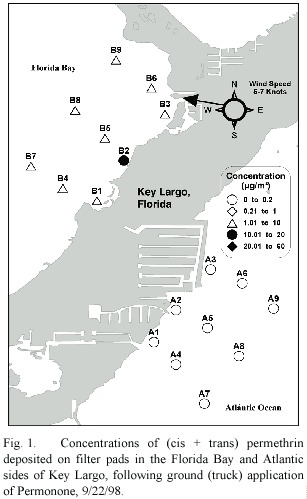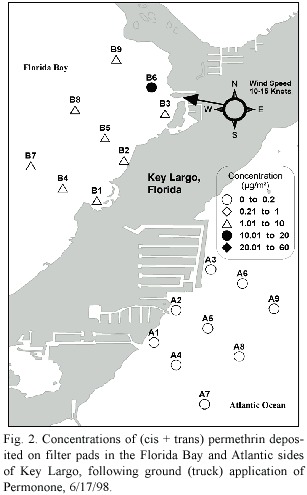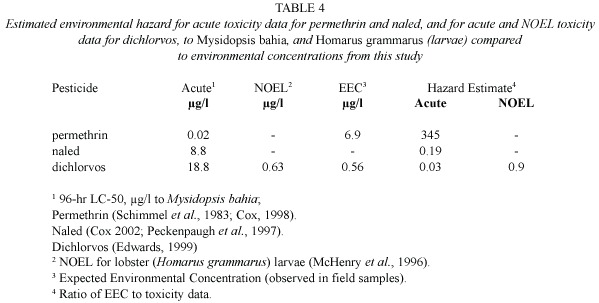Services on Demand
Journal
Article
Indicators
-
 Cited by SciELO
Cited by SciELO -
 Access statistics
Access statistics
Related links
-
 Similars in
SciELO
Similars in
SciELO  uBio
uBio
Share
Revista de Biología Tropical
On-line version ISSN 0034-7744Print version ISSN 0034-7744
Rev. biol. trop vol.53 suppl.1 San José May. 2005
Aerial and Tidal Transport of Mosquito Control Pesticides into the Florida Keys National Marine Sanctuary
R.H.Pierce1 ,M.S.Henry 1 ,T.C.Blum1 &E.M.Mueller2
1 Mote Marine Laboratory,1600 Ken Thompson Parkway,Sarasota,Florida,34236,USA.Phone (941)388-4441,Fax (941)388-4312;rich@mote.org;mhenry@mote.org;pcblum@mote.org
2 Perry Institute of Marine Science,1703 Von Phister Street,Key West, Florida, 33040, USA; evmresearch@yahoo.com
Received 15-I-2004. Corrected 18-XI-2004. Accepted 29-III-2005.
Abstract: This project was undertaken as the initial monitoring program to determine if mosquito adulticides applied along the Florida Keys cause adverse ecological effects in the Florida Keys National Marine Sanctuary (FKNMS).The study monitored the distribution and persistence of two mosquito adulticides,permethrin and dibrom (naled),during three separate routine applications by the Florida Keys Mosquito Control District.The approach was to determine if toxic concentrations of the pesticides entered the FKNMS by aerial drift or tidal transport.The amount of pesticide entering the FKNMS by way of aerial drift was monitored by collection on glass fiber filter pads,set on floats in a grid pattern on either side of the FKNMS.Permethrin was recovered from filter pads on the leeward side for each of the three applications,ranging from 0.5 to 50.1 µg/m2 throughout the study.Tidal current transport was monitored by collection of surface and subsurface water samples at each grid site.Tidal transport of naled and dichlorvos (naled degradation product)was apparent in the adjacent waters of the FKNMS.These compounds were detected in subsurface,offshore water at 0.1 to 0.6 µg/l,14 hr after application.Permethrin was not detected in offshore water samples; however, concentrations ranging from 5.1 to 9.4 µg/l were found in surface water from the canal system adjacent to the application route.Comparison of the observed environmental concentrations with toxicity data (permethrin LC-50,96 hr for Mysidopsis bahia =0.02 µg/l)indicated a potential hazard to marine invertebrates in the canals with possible tidal transport to other areas.
Key words:Organophosphate,pyrethroid,naled,dichlorvos,permethrin,mosquito adulticides.
This project was undertaken to determine if the mosquito adulticides,permethrin and dibrom (naled),applied along the Florida Keys, in Monroe County,Florida,USA,could cause adverse ecological effects in the Florida Keys National Marine Sanctuary (FKNMS).Dibrom- 14,active ingredient,naled (1,2-dibromo-2,2- dichloroethyl dimethyl ester,phosphoric acid), is a fast acting,nonpersistant organophosphate insecticide.Although hydrolysis occurs fairly rapidly in seawater (half-life @pH 7 =16 hr, decreasing with increasing pH),the primary degradation product,dichlorvos (2,2-dichlo-rovinyl dimethyl phosphate),is also toxic to aquatic invertebrates (Cox 2002).Both naled and dichlorvos are classified as very highly toxic to aquatic invertebrates,with an acute toxicity (96 hr LC50)for Mysidopsis bahia of 8.8 µg/l for naled,and 19 µg/l for dichlorvos (Johnson and Finley 1980,Peckenpaugh et al.1997,Edwards 1999).Therefore,environmental assessment of the effects of naled must include analyses and toxicological testing for dichlorvos as well.
Permethrin is a broad spectrum,synthetic pyrethroid insecticide,consisting of a mixture of cis and trans isomers.The cis isomer is highly toxic (mouse LC-50,85 mg/kg), however,the commercial mixture is less toxic (LC-50 of 410 mg/kg)(Kidd and James 1991). Permethrin is applied with a synergist, piperonyl butoxide (PBO)that inhibits the insect s natural metabolic defense against pyrethroids, greatly enhancing its insecticidal effectiveness (Cox 1998).Although relatively nontoxic to mammals and birds,permethrin is very highly toxic to aquatic invertebrates and exhibits a high bioconcentration factor in aquatic organisms due to its insolubility in water.Schimmel et al.(1983)reported the 96 hr LC-50 to be 0.02 µg/l for mysid shrimp,0.2 µg/l for penaeid shrimp and 2.2 µg/l for the silverside minnow, Menidia sp.The half-life of permethrin in water and sediment was found to be <2.5 days, and was dependent upon photolysis in water and on microbial degradation in sediments (Schimmel et al.1983).
Previous studies of thermal fog applications showed drift of naled and fenthion into nontargeted (no-spray)terrestrial habitats in the Florida Keys.Pesticide residues collected on cellulose pads exhibited up to 90 µg/m2 naled at 15 m inside a Pineland no-spray zone, with naled drift detected up to 750 m into the no-spray zone.At 6 hr after application, naled concentrations on the pads diminished to about 50%that observed at 1.5 hr.Fenthion was detected in about the same concentrations 50 m into a wildlife refuge,but none was detected at 500 m (Hennessey et al.1992). These results show the potential for non-target marine organisms exposure to drift from mosquito adulticide applications.
A study of both permethrin and naled/dichlorvos was conducted in a mangrove community and residential water collection systems on Grand Cayman Island following applications over residential areas as well as coastal mangrove forests (Pierce and Henry 1988). These results showed persistence of permethrin in mangrove tree leaves and in association with suspended sediment in the water cisterns,but none was detected in saltmarsh water pools. Although no naled or dichlorvos was detected in the mangrove community following application,residues of both were recovered from cistern water up to 16 hr after application,but no pesticide residues were detected in drinking water as it came out of the tap (Pierce and Henry 1988).
Although naled and permethrin are considered to be relatively nonpersistent in an aquatic environment, even short exposure periods to pesticides can have adverse impacts on susceptible life stages of aquatic invertebrates.The mosquito larvicide,temephos,(an organophosphate)was found to cause 50%mortality in fiddler crab larvae through the first molt,five to seven days after exposure in the field for only 4 hr,following ultra low volume (ULV) application in an intertidal saltmarsh (Pierce et al.2000).This evidence for adverse effects on aquatic invertebrates from short-term exposure to a mosquito pesticide supports the need for establishing the distribution and persistence of pesticides in the FKNMS.
Methods and materials
The study location was Key Largo,Florida, USA.The geographic location is at latitude 25 °8 N,80 °24 W.The Florida Keys Mosquito Control District (FKMCD)provided both permanone as well as dibrom applications within the same area of Key Largo,(between mile marker (MM)#89 and MM #91).Dibrom was applied as ultra low volume (ULV)technical product Dibrom-14 (Valent USA Corp.), 21.3 g/ha using C-47 aircraft.Permethrin was applied as the technical product,Permanone (4%cis +trans permethrin/8%PBO,Agrevo Corp.)from trucks as ground ULV applied at 0.4 l/ha.Prior to each test application,a grid of nine sampling sites covering an area of approximately 1.5 km along shore to 1 km offshore, was established in both the Florida Bay side as well as the Atlantic side of Key Largo,to provide a control (windward)and a drift (leeward) sampling area,depending on the direction of the wind (Fig.1).
Samples collected at each of the 18 sampling sites consisted of:
a) Filter pads to determine pesticide deposition as a result of aerial drift,placed on floating platforms above the water surface to avoid water splashing on to the filter surface,
b)water surface micro layer to determine if the pesticides accumulated from deposition onto the water surface,and
c)water subsurface (about 20 cm depth)to determine the amount of pesticide in the water column to which marine organisms would be exposed.
A summary of the sample collection locations and times (Table 1)shows that samples were collected just prior to each pesticide application to monitor for residual pesticides,and again at 2-4 hr after each application.Persistence in the aqueous environment was monitored by collection of surface and subsurface water samples again at 12 hr intervals post application as deemed necessary for each study.
Water quality parameters were monitored for each site,including temperature,dissolved oxygen, pH,salinity and conductivity.A strict quality control program was followed including field blanks,spiked standard recoveries and surrogate recovery standards added to each sample.Sample custody sheets were maintained and samples processed according to the written standard operating procedure,as approved by the U.S.Environmental Protection Agency. Sample processing was initiated immediately in the field with the addition of dichloromethane solvent to initiate extraction and to reduce degradation of the parent compounds. Samples were brought back to Mote Marine Laboratory (MML)for further processing and gas chromatography-mass spectrometry (GC-MS)analysis.
GC-MS analyses were performed using a Varian Instruments (Sugar Land,TX)Saturn II ion trap Mass Spectrometer coupled with a Varian 3400 gas chromatograph.GC separations were performed on a 30 m glass capillary DB-5 MS column.
Pre-application samples for the first study, June 16,1998,were collected simultaneously from the Atlantic and Bay sites at 17:00 to 18:40.The permanone was applied by ground ULV starting at 20:00,with the first series of filters,surface and sub-surface water samples collected from 22:00 to 01:00.Dibrom was subsequently applied by air ULV at 07:00 on 6/17/98,with the post application sampling occurring from 09:00 to 11:30.The 24 hr permanone (coincident with the 12 hr dibrom) sampling occurred from 17:00 to 18:30 on 6/17/98.One final sampling was performed on 6/18/98 from 08:30 to 10:00 on both the Bay and Atlantic sites.
The second study (7/28/98)pre-application samples were collected from 15:00 to 17:00 on both the Bay and Atlantic sides simultaneously,with the permanone application following at 20:00.The post-application samples were collected from 22:00 to 00:45 on both the Bay and Atlantic sides concurrently. Dibrom was applied the next morning at 07:00. The first pre-application sampling for the Bay side was obtained from 9:45 to 11:15,however,due to boat problems;the Atlantic side was not sampled until 12:38 to 14:00,delaying the post-application samples for that area.The second dibrom sample collection,simultaneous with the third permanone sampling was obtained from the Bay side from 14:00 to 15:30.No further samples were collected from the Atlantic side.
The third study (9/22/98)pre-application samples were collected from 16:20 to 17:30 in the bay and Atlantic and canal sites simultaneously,with permanone application initiated at 20:00.Dibrom was not applied during this study due to evacuation of aircraft from the impending Hurricane Georges.The 12 hr post permanone application sampling was performed from 8:40 to 10:00 on 9/22/98.
Results
First Application -June 16-18,1998: Pesticide concentrations on the filter pads collected 3-6 hr after application recovered total (cis +trans)permethrin,ranging from 4.6 to 15.8 µg/m2 on filters in the Florida Bay (down-wind)side of the application area.None was detected on the Atlantic side (Fig.1),which is consistent with the wind direction out of the ESE at 5 kts.Subsequent aerial application of naled the following morning resulted in no detectable naled or dichlorvos on filters from the Atlantic side,and one sample (B6)showing 1.6 µg/m2 naled and a different one (B8)showing 0.16 µg/m2 dichlorvos on Bayside filters.
No permethrin or naled was detected in the surface water from either side,with dichlorvos indicated at one Atlantic site (A3)at 1.3 µg/l. These results show that although some permethrin was deposited by drift onto the filter papers,none was detected in the surface water microlayer around the filters, indicating rapid dispersion-dissolution into the water,and/or rapid degradation by hydrolysis and photolysis. The low solubility of permethrin would cause it to adsorb to suspended particles, however, permethrin associated with suspended particles in the water column would have been recovered with the solvent extraction method.
Subsurface water samples (collected about 20 cm below the surface)showed no pesticide residues detected on the Bay side (except a trace of dichlorvos at one site)2-4 hr after naled application.Naled was detected in only one sample (0.19 µg/l at A3)in the Atlantic side.Dichlorvos was observed in 50%of the Atlantic samples 2-4 hr after application,in concentrations ranging from 0.08 to 0.56 µg/l.
Some dichlorvos was still detected in three of nine sites during the 10 to 11 hr sampling period,ranging from 0.05 to 0.33 µg/l,suggesting that the breakdown product of naled (dichlorvos),was transported to these sites in the water column and that dichlorvos,not naled is the contaminant of concern for exposure.The most likely source would be tidal movement out of the canal systems of the residential area adjacent to where the pesticides were applied.
Quality control measures included determination of the lower limits of detection for each pesticide as well as recovery and analysis of standard pesticide mixtures in each matrix (Table 2).The average values for water quality parameters (Table 3)show that the Bay water had lower salinity than the Atlantic with higher dissolved oxygen (DO)and pH.
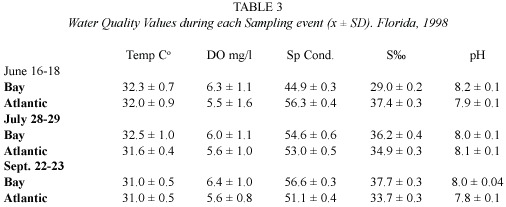
Second Application -July 28-29,1998: Results of the second application were similar to the first,with no permethrin found on filter pads on the Atlantic (up-wind)side and all filter samples in the Bay side exhibiting total (cis +trans)permethrin concentrations ranging from 1.1 to 17.1 µg/m3 at 3-6 hr after application (Fig.2).Dichlorvos was detected at site B4 (0.4 µg/m2 ).These results are consistent with the wind direction ESE at 12 kts,causing permethrin drift into Florida Bay.
Surface water samples showed no permethrin,dibrom or dichlorvos,indicating no accumulation at the water surface microlayer.Sub-surface water samples exhibited much lower amounts of dichlorvos than were observed from the first application,yet two out of nine sites did indicate trace amounts (0.07 and 0.09 µg/l),one site (B6)containing 0.07 µg/l of permethrin.It is possible that the low dichlorvos concentrations resulted from the delayed sampling time (3 hr late due to boat problems)and that higher wind velocity dispersed the aerially applied pesticides, reducing the amount deposited in any given area of the FKNMS and the canal water.Bay water had a slightly higher temperature than the Atlantic,and higher DO,yet the temperature and pH were about the same for Bay and Atlantic water (Table 3).
Third Application -September 22-23, 1998:The sampling protocol for the third application was changed to include samples of water from the residential canals opening to the Atlantic side of the study area.This sampling episode was scheduled to occur just as hurricane "Georges "was bearing down on the Keys,so it was terminated prematurely. Fortunately,we were able to collect filter and water samples from both the Bay and Atlantic sides and from the canals before and after the evening permanone application.The 12 hr post sampling collection also was obtained the following morning,prior to evacuating from the hurricane.The wind direction during the permanone application was opposite that of the two previous sampling episodes,this time from the north at 5-10 kts.The Bay water had higher salinity,dissolved oxygen and pH than Atlantic water,yet the temperatures were about the same (Table 3).
Permethrin concentrations found on the filters,including the canal system,are given in Figure 3.These show permanone collected on the filters in all except one of the Atlantic sites, with cis +trans permethrin collected on filters in the canal ranging from 13.6 to 51.0 µg/m2. Filters on the Bay side exhibited trace amounts of permanone on four out of 10 sample sites.
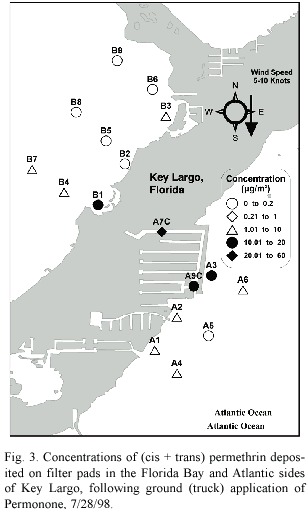
Surface water was collected only from the canals.These results show permanone in all of the surface water microlayer samples ranging from 5.1 to 9.4 µg/l at 2-4 hr after application.
Sub-surface water samples also were collected at each site 2-4 hr after application and again at 12 hr after.No permethrin was detected in any of the subsurface samples,which is consistent with the previous two applications.Unfortunately,we were not able to monitor for naled or dichlorvos in the canal system.Naled was not applied during this study because the airplanes were evacuated due to the pending hurricane.
Discussion
The potential hazard associated with pesticide applications can be assessed by comparing the environmental concentrations with the toxicity to representative organisms that would be exposed.The hazard quotient,the ratio of the environmental concentration divided by the no observable adverse effects level (NOEL),with correction factors for each pesticide for each species considered,provides an estimate for a safe environmental concentration (Gargas et al.1999).Although a NOEL was not available for representative marine invertebrates for all of the pesticides investigated in this study,a hazard can be assessed by comparison of literature toxicity values for representative invertebrates,with the pesticide concentrations observed in FKNMS water during this study (Table 4).
Permethrin -Permethrin (both cis and trans)was found in most of the leeward filter samples, however,concentrations exceeding quantifiable amounts in water were found primarily in the canal surface water samples (range 5.1 to 9.4 µg/l).Permethrin concentrations in canal water greatly exceeded the 96 hr LC-50 values (0.02 µg/l)indicating a potential environmental hazard to aquatic invertebrates in the canals,depending on the duration of exposure.Potential sub lethal effects of permethrin on reproduction and development of marine invertebrates also should be considered because the lower limit of detection (0.07 µg/l)was greater than the acute toxicity level (0.02 µg/l), precluding detection of permethrin concentrations between the LOD and LC-50 levels.
Naled -Naled was not detected on filter pads,nor in the surface water samples. The only instance of a detectable amount of naled (0.19 µg/l)was in one sub-surface water sample on the Atlantic side on 6/17/98.This concentration was less than the acute toxicity, indicating no acute toxicity effects. However, no NOEL for naled was found for marine invertebrates,so the sublethal effects could not be determined.The amount of naled (and dichlorvos)deposited into canals during aerial applications should be determined to address the potential hazard.
Dichlorvos DDVP -The primary degradation product of naled,dichlorvos,was not found in quantities exceeding the acute toxicity LC-50 of 18.8 µg/l for mysidopsis bahia nor the NOEL (0.63 µg/l)for homarus grammarus larvae indicating no acute toxicity likely for those organisms.However,possible higher concentrations in canals raises concern for a potential hazard for sub-lethal effects to sensitive marine invertebrates in the canal systems.Although dichlorvos in the subsurface water could result from degradation of dibrom from aerial deposition, the most likely source would appear to be from tidal flushing of the pesticide residues from the residential canal systems,where the mosquito control pesticides were applied.
Conclusions
These results show permethrin drift into the FKNMS from ground (truck)permanone applications by deposition on glass fiber filters held above the water surface,yet only trace amounts were detected in the surface or subsurface water samples in Florida Bay or in the Atlantic Ocean.Neither naled nor its degradation product,dichlorvos,were detected as drift on the filter pads,however sub lethal concentrations (0.5 to 0.56 µg/l)were found in some subsurface samples several hours after application,indicating aqueous transport from residential canals to the FKNMS. Concentrations of permethrin in canal water samples were of sufficient amounts (5.1 to 9.4 µg/l)to be considered an environmental hazard to sensitive marine invertebrates,depending on the duration and mode of exposure.
Deposition of high amounts of permethrin into the canals suggests the importance of more closely monitoring the amount of pesticides deposited into residential canals and partially enclosed embayments,where susceptible life stages of marine organisms could be exposed to toxic concentrations.Further studies are needed to assess the concentration,distribution and persistence of mosquito control pesticides in the canals and adjacent waters of the FKNMS,along with determining the NOEL for these pesticides on keystone marine organisms, to provide a hazard assessment.
Acknowledgments
This project was funded by the U.S. Environmental Agency,Florida Keys National Marine Sanctuary Water Quality Program.The authors greatly appreciate the Florida Keys Mosquito Control District s logistical support and coordinated aerial and ground applications of the mosquito adulticides.
Resumen
Para determinar si los adulticidas de mosquitos,aplicados en los Cayos de la Florida,causan efectos ecológicos adversos en el Santuario Marino Nacional de los Cayos de la Florida,se monitoreó la distribución y persistencia de dos adulticidas de mosquitos.Estos fueron permetrina y dibrom (naled).Se trabajó durante tres aplicaciones rutinarias hechas por la Unidad de Control de Mosquitos de los Cayos de la Florida.La finalidad era determinar si concentraciones tóxicas de los plaguicidas llegaban al santuario por transporte aéreo o por las corrientes de marea.La cantidad de plaguicida que entra por vía aérea fue monitoreada utilizando filtros de fibra de vidrio,montados en flotadores dispuestos sistemáticamente a ambos lados del FKNMS. La Permetrina fue recuperada en filtros a sotavento del santuario durante tres aplicaciones,con un ámbito entre 0.5 y 50.1 µg/m2 durante todo el estudio.El transporte por corrientes de marea fue monitoreado recolectando muestras de agua superficiales y subsuperficiales en puntos definidos.Se notó el transporte por mareas de naled y diclorvos (producto degradado de naled)en aguas adyacentes al santuario.Estos compuestos fueron detectados en muestras subsuperficiales en aguas fuera de la costa con concentraciones de 0.1 a 0.6 µg/l,14 hr después de la aplicación.La Permetrina no fue detectada en muestras de agua fuera de la costa;sin embargo,hubo concentraciones de 5.1 a 9.4 µg/l en aguas superficiales del sistema de canales adyacente a la ruta de aplicación. Comparaciones de las concentraciones observadas con información toxicológica (permetrina LC-50,96 hr para Mysidopsis bahia =0.02 µg/l)indican un peligro potencial para invertebrados marinos en los canales y la posibilidad de transporte por mareas a otras áreas.
Palabras clave:Organofosforados,piretroides,naled, diclorvos,permetrina,adulticidas de mosquitos.
References
Cox,C.1998.Insecticide Fact Sheet:Permethrin.J.Pest. Reform.18:14-20. [ Links ]
Cox,C.2002.Insecticide Fact Sheet:Naled (dibrom).J. Pest.Reform.22:16-21. [ Links ]
Gargas,M.L.,B.L.Finley,D.J.Paustenbauch &T.F.Long. 1999.Environmental health risk assessment:theory and practice,p.1750-1809.In B.Ballantyne,T.C. Marrs &T.Syversen (eds.).General and Applied Toxicology,2 nd Ed.,Groves Dictionaries,Inc.,New York,NY. [ Links ]
Hennessey,M.K.,H.N.Nigg &D.H.Habeck.1992. Mosquito (Diptera:Culicidae)adulticide drift into Wildlife Refuges of the Florida Keys.Entomol.Soc. Amer.14:714-720. [ Links ]
Johnson,W.W.&M.T.Finley.1980.Handbook of Acute Toxicity of Chemicals to Fish and Aquatic Invertebrates.Resource Publication 137.U.S. Department of Interior,Fish and Wildlife Service, Washington,DC.Pp.5-17. [ Links ]
Kidd,H.&D.R.James (eds.).1991.The Agrochemicals Handbook.3 rd Ed.Royal Society of Chemistry Information Services,Cambridge,UK.Pp.2-13. [ Links ]
Pierce,R.H.&M.S.Henry.1988.Pesticide Residues in Mangrove Communities and Cistern Water of the Cayman Islands.Final Report to Cayman Islands Government Mosquito Research and Control Unit, Grand Cayman,C.I.,BWI.76 p. [ Links ]
Pierce,R.H.,M.S.Henry,D.Kelly &W.Kozlowski. 2000.Hazard assessment of Temephos applied to a Southwest Florida saltmarsh community.J.Environ. Toxicol.Chem.19:501-507. [ Links ]
Schimmel,S.C.,R.L.Garnas,J.M.Patrick &J.C.Moore. 1983.Acute toxicity,bioconcentration and persistence of AC 222,705,Benthiocarb,Chlorpyrifos,Fenvalerate, Methyl Parathion,and Permethrin in the estuarine environment.J.Agri.Food Chem.31:104-113. [ Links ]
Internet references
Edwards,J.1999.U.S.Office of Prevention,Pesticides and Toxic Substances,EFED s comments for dichlorvos,pp.15-16 (www.epa.gov/oppsrrd1/op/ddvp/efedrisk.pdf) [ Links ]
Peckenpaugh,J.,S.Termes &C.Laird.1997.U.S. EPA,Office of Prevention,Pesticides and Toxic Substances, EFED s Reregistration Chapter C for naled.Special Review and Reregestration Div.pp. 9-10 (www.epa.gov/pesticides/op/status.htm) [ Links ]













